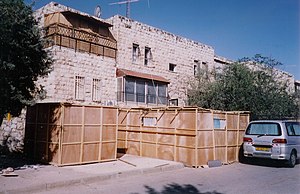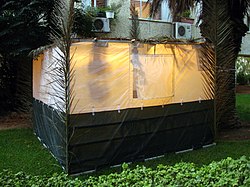Sukkah: Difference between revisions
No edit summary |
add all metrial from Sukkah hopping |
||
| Line 65: | Line 65: | ||
The custom of inviting guests to the sukkah extends to living guests as well. Many people invite family, friends, neighbours, or people who are alone to join them for a snack or a meal. Anyone, including [[gentile|non-Jews]], are more than welcome inside a sukkah. |
The custom of inviting guests to the sukkah extends to living guests as well. Many people invite family, friends, neighbours, or people who are alone to join them for a snack or a meal. Anyone, including [[gentile|non-Jews]], are more than welcome inside a sukkah. |
||
==Sukkah hopping== |
|||
"Sukkah hopping" is an American phenomenon of visiting multiple sukkahs in order to eat in each sukkah visited. It has become a tradition in many sizable Jewish communities during [[Sukkot]], particularly among children. While sukkah hopping can occur on any day of Sukkot other than [[Shabbat]], it most commonly takes place on the first two days of Sukkot outside of [[Israel]]. Sukkah hopping is generally avoided on Shabbat, as not all communities have an [[eruv]], and in places where an eruv exists, use of the eruv for this purpose is discouraged. |
|||
In communities where sukkah hopping is widely practiced, owners of sukkahs are encouraged to place food (usually snacks) in their sukkahs for the sukkah hoppers |
|||
The supposed purpose of sukkah hopping is to enable its participants to recite the [[bracha|blessing]] [[Leshev B'Sukkah]] as many times as possible<ref>http://www.ascentofsafed.com/cgi-bin/ascent.cgi?Name=sukkot6761</ref>. It is therefore advised to sukkah owners that food items in which the [[M'zonot]] blessing is recited be placed for sukkah hoppers. These include items made from grains, such as cake, cookies, or pretzels. It is common, however, for other types of food, such as fruit, candy, or chips to be found. |
|||
Some synagogues run ''sukkah hops'' in which participating members walk or drive between the sukkahs of several members who have volunteered their sukkahs for the event. The volunteering members then serve some type of food, often a course of a meal, in their sukkah for the guests to enjoy. |
|||
The practice of sukkah hopping has faced criticism. Parents of some participating children are concerned about the large amount of [[junk food]] that may be collected and consumed by their children, and that the food may be unsafe to eat or not meet their [[kashrut]] standards. Also, some feel that the practice resembles "[[trick-or-treating]]." Participants will often enter unattended sukkahs or sukkahs where people are napping, which is viewed as being akin to trespassing<ref>http://www.wherewhatwhen.com/read_articles.asp?id=28</ref>. |
|||
==External links== |
==External links== |
||
| Line 71: | Line 84: | ||
==References== |
==References== |
||
{{reflist}} |
|||
<References/> |
|||
{{Sukkot}} |
{{Sukkot}} |
||
Revision as of 06:15, 18 September 2008

A sukkah is a temporary dwelling that Jews use during the holiday of Sukkot.
Structure

According to Halakha, a sukkah is a structure consisting of a roof made of organic material which has been disconnected from the ground (the s'chach). A sukkah must have at least 2-1/2 walls. It should be at least three feet tall, and be positioned so that all or part of its roof is open to the sky (only the part which is under the sky is kosher.) A sukkah can be built on the ground or on an open porch or balcony. Indeed, many observant Jews who design their home's porch or deck will do so in a fashion that aligns with their sukkah building needs. Portable sukkahs have recently become available for those who have little space, or for those who are travelling (in order to have a place to eat one's meals).

In practice, the walls of a sukkah can be constructed from anything ranging from wood to canvas to aluminium. The walls may also be part of a house or fence. The specific details of what constitutes a wall, how short/tall a wall can be, whether there can be spaces between the walls and the roof, and the exact material required for the s'chach (roofing) can be found in various exegetical texts.
S'chach

S'chach is the Hebrew name for the material used as a roof for a sukkah. S'chach must be something that grew from the ground but is currently disconnected from it. Palm leaves, bamboo sticks, pine branches and wood, as well as many other types of organic material, could all be used for s'chach, unless they were processed for a different use.
The s'chach must be placed such that there is more shade than sun. However, there must be sufficient gaps between the pieces of s'chach so that rain can come through.
Decorations

Many people hang decorations such as dried or plastic fruit, streamers, shiny ornaments, and pictures from the interior walls and ceiling beams of a sukkah. Families may also line the interior walls with white sheeting, in order to recall the "Clouds of Glory" that surrounded the Jewish nation during their wanderings in the desert. The Chabad custom is not to decorate the sukkah, as the sukkah itself is considered to be an object of beauty.[1]
What is done in the sukkah?
The basic requirements of halakha are that eating of meals and sleeping should be conducted in the sukkah. However, one is not expected to remain in the sukkah if he would be very uncomfortable there. For this reason, Jews living at northern latitudes will generally not sleep in the sukkah due to the cold temperatures of autumn nights. Some Jews in these locales will spend some time in the sukkah eating and relaxing but go indoors to sleep.

In Israel and other temperate climates (such as Florida, Australia, and Southern California), observant Jews will often conduct all their eating, studying, and sleeping activities in the sukkah. Many Jews will not eat anything except water or fruit outside the sukkah. In Israel, it is common practice for hotels, restaurants, snack shops, and outdoor tourist attractions (such as zoos) to provide an sukkah for their guests to eat in. Lubavitcher and Belzer[2] Hasidim differ from other Orthodox Jews in that they don't sleep in the sukkah due to its intrinsic holiness.[3]
Though one need not eat or sleep in the sukkah if it is raining, Lubavitcher Hasidim will still eat there.
Symbolism
Although the festival of Sukkot is a joyous occasion, and is referred to in Hebrew as Yom Simchateinu (the day of our rejoicing) or Z'man Simchateinu, (the season of our rejoicing), the sukkah itself symbolises the frailty and transience of life. It also reminds its dwellers that true security comes from faith in God, rather than from money or possessions.[4]
Ushpizin
Template:Distinguish2 During the holiday, Jews invite seven spiritual "guests" (known as ushpizin in Aramaic) to be with them in the sukkah. These ushpizin are the "Seven Shepherds of Israel":
- Abraham
- Isaac
- Jacob
- Joseph (the three Patriarchs and Jacob's most famous son)
- Moses (the most influential of the Hebrew prophets)
- Aaron (Moses's brother, the first Kohen Gadol, or High Priest)
- David (a very significant king of Israel, the messiah is said to be a descendant of David)
According to tradition, each night a different one of the ushpizin enters the sukkah first and the other six follow. Some people say a special prayer welcoming them to the sukkah in the order in which they come. Each of the ushpizin has a unique lesson to teach us that parallels the spiritual focus of the day on which they visit.
According to Chabad tradition, another set of ushpizin come along with those listed above. There is a unique connection between the two ushpizin that visit each night, particularly as explained in the works of Rabbi Menachem Mendel Schneerson.[5]
- Avraham Avinu - Rabbi Yisroel Baal Shem Tov
- Yitzchak Avinu - Rabbi DovBer, Maggid of Mezeritch
- Yaakov Avinu - Alter Rebbe (Rabbi Shneur Zalman of Liadi)
- Moshe Rabbeinu - Mitteler Rebbe (Rabbi DovBer)
- Aharon HaKohen - Tzemach Tzedek (Rabbi Menachem Mendel)
- Yosef Hatzadik - Rebbe Maharash (Rabbi Shmuel Schneersohn)
- Dovid HaMelech - Rebbe Rashab (Rabbi Sholom Dovber Schneersohn)
In recent times, some Jews add seven spiritual women, or ushpizot, to enter their sukkah. These are the biblical Sarah, Miriam, Deborah, Hannah, Huldah, Abigail, and Esther.[6]
The custom of inviting guests to the sukkah extends to living guests as well. Many people invite family, friends, neighbours, or people who are alone to join them for a snack or a meal. Anyone, including non-Jews, are more than welcome inside a sukkah.
Sukkah hopping
"Sukkah hopping" is an American phenomenon of visiting multiple sukkahs in order to eat in each sukkah visited. It has become a tradition in many sizable Jewish communities during Sukkot, particularly among children. While sukkah hopping can occur on any day of Sukkot other than Shabbat, it most commonly takes place on the first two days of Sukkot outside of Israel. Sukkah hopping is generally avoided on Shabbat, as not all communities have an eruv, and in places where an eruv exists, use of the eruv for this purpose is discouraged.
In communities where sukkah hopping is widely practiced, owners of sukkahs are encouraged to place food (usually snacks) in their sukkahs for the sukkah hoppers
The supposed purpose of sukkah hopping is to enable its participants to recite the blessing Leshev B'Sukkah as many times as possible[7]. It is therefore advised to sukkah owners that food items in which the M'zonot blessing is recited be placed for sukkah hoppers. These include items made from grains, such as cake, cookies, or pretzels. It is common, however, for other types of food, such as fruit, candy, or chips to be found.
Some synagogues run sukkah hops in which participating members walk or drive between the sukkahs of several members who have volunteered their sukkahs for the event. The volunteering members then serve some type of food, often a course of a meal, in their sukkah for the guests to enjoy.
The practice of sukkah hopping has faced criticism. Parents of some participating children are concerned about the large amount of junk food that may be collected and consumed by their children, and that the food may be unsafe to eat or not meet their kashrut standards. Also, some feel that the practice resembles "trick-or-treating." Participants will often enter unattended sukkahs or sukkahs where people are napping, which is viewed as being akin to trespassing[8].
External links
Template:Yeshiva site Template:Yeshiva site
References
- ^ How To Build Your Sukkah
- ^ Nitei Gavriel, Hilchos Rosh Hashanah Ch. 29 note 9 (5754 Edition)
- ^ The Sukkah and Sleeplessness
- ^ Shelter of Faith
- ^ Cf. Mayonei HaYeshua.
- ^ about ushpizot
- ^ http://www.ascentofsafed.com/cgi-bin/ascent.cgi?Name=sukkot6761
- ^ http://www.wherewhatwhen.com/read_articles.asp?id=28

